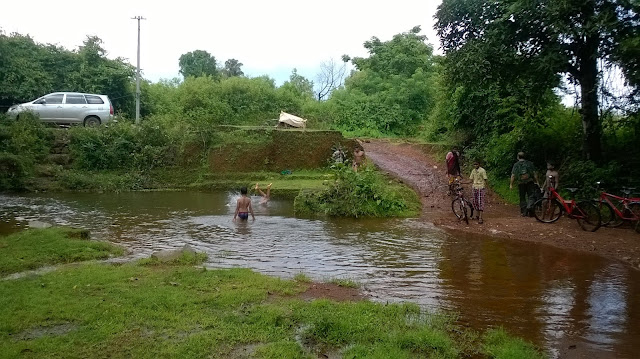A couple of years back, I had visited Lalita’s mothers home
– Lalita is my help who works on the farm as well as helps me in the house
work. In the front yard of their home I
had noticed a beautiful structure made of hay.
Intrigued, I had
asked about it and they had explained that it was made by her brother Nagraj to
store their harvest of rice paddy in it.
It is a traditional form of storing paddy and very few people make it
now a days. It seemed to be dying
art. I was keen on seeing how it is made
and I asked her to inform me the next time her brother would make it. ‘Oh it is made only once a year’ she said.
‘Doesn’t matter, let me know next year’ I told her.
But as luck would have it, in spite of her
informing me, we were unable to go and 3 years passed before we got a chance to
see it actually being made.
So this year when Lalita informed me that her brother was planning to make the Hemmudi
a few days later, we decided to keep that day free. He was to start at 2 pm after lunch, so we
planned accordingly and went to their home.
Their front yard was spruced up and made spotlessly clean
and a fresh layer of cowdung had been smeared on it. Cow dung is a natural anti-microbial and has
insect repelling properties – so is it any wonder that the traditional method
of layering the front yard with cowdung
instead of cement is still so popular in
the villages?
A spot was chosen and Nagaraj’s mother drew a Rangoli design
with quick strokes. Then bunches of hay
were laid out systematically with the cut ends in the centre and the other end
fanning out to make a large circle. Once
the first circle was complete, a second concentric, slightly smaller one was
made on top of it and then another until innermost circle completely covered
the ground.
All along Lalita’s young
kids aged 8 and 11 scurried around bringing
bunches of hay from the stack that was a little distance away. Soon the enormous circle of hay was
ready. A large plastic sheet was placed in the centre to prevent grains from slipping
thru the hay and also to prevent any moisture from seeping in, in case of any unseasonal
rain. Then Nagaraj lifted a large basket
into which some paddy had been poured from
one of the sacks of rice lined up against the wall of the house. He said a prayer and then emptied the first lot
of paddy onto the sheet.
His college
going nephew joined in along with a neighbour to help lift the sacks and bring
them to Nagaraj. He would tip each one and flatten the mound carefully within the circle. After a sizeable mound was created, then the
sides had to be raised. The hay was bent
upwards and a thick rope was wound around the base of the Hemmudi.
Now the whole thing looked like a large grass
tub filled with paddy. Now the next
layer of the Hemmudi wall had to be built.
The kids pitched in carrying the hay to Nagaraj who carefully placed
each bunch vertically supported on the outside by the ring of hay and on the
inside by the paddy.
The ring was
completed, secured with ropes and then the piling in of the paddy resumed. So layer by layer, the Hemmudi was
constructed, finally holding close to 30 quintals of paddy.
As the last circle of hay was being placed,
Lalita’s nephew expertly prepared a
metal ring with ropes hanging around the sides, that was to go on top of the
Hemmudi to secure the top in place.
The 2 kids ran around busily bringing the
hay bunches and passing them to Nagaraj who was on the top of the Hemmudi which
was now almost 9 feet in height. He
covered the top with a generous layer of hay, then a plastic sheet was placed
on top, followed by the ring. The ropes
hanging from the ring were securely fastened down to the sides of the Hemmudi.
In the meantime, the youngsters had fetched
some clayey mud and were busy mixing it with water to make a thick paste. This was piled around the base and plastered
into place with their hands to make a perfect seal.
The ladies busied themselves cleaning out the
remnants of the fallen hay, folding the emptied sacks neatly and sprucing up
the place and bringing in bunches of
mango leaves and flowers for the Pooja.
**
The Hemmudi is now finally completed, decorated with flowers
and leaves. Nagaraj’s mother
brings out a platter with an oil lamp, flowers. Coconut and agarbattis. He performs a small Pooja of the Hemmudi and
then it is time for them to relax. A
feast of Chicken curry and rice has been prepared by the mother and they all
troop into the house for an early dinner.
They insist on us joining them too, but it is just 6.30 pm, a bit too
early for us. So they pack some for us to take home. We leave for home, happy to have been able to see the making of
the Hemmudi.
And Vivek had clicked a whole bunch of videos and compiled
this, click to see the video.

























